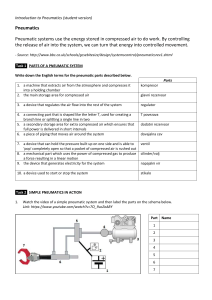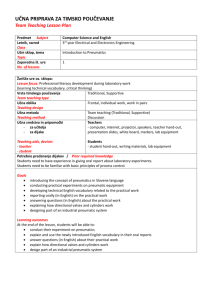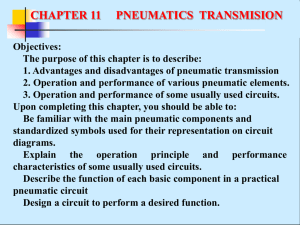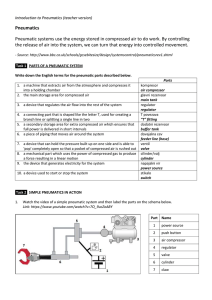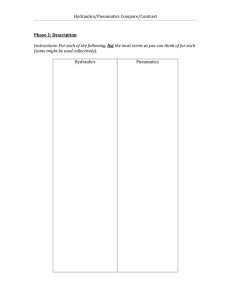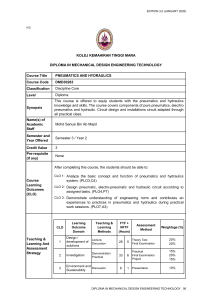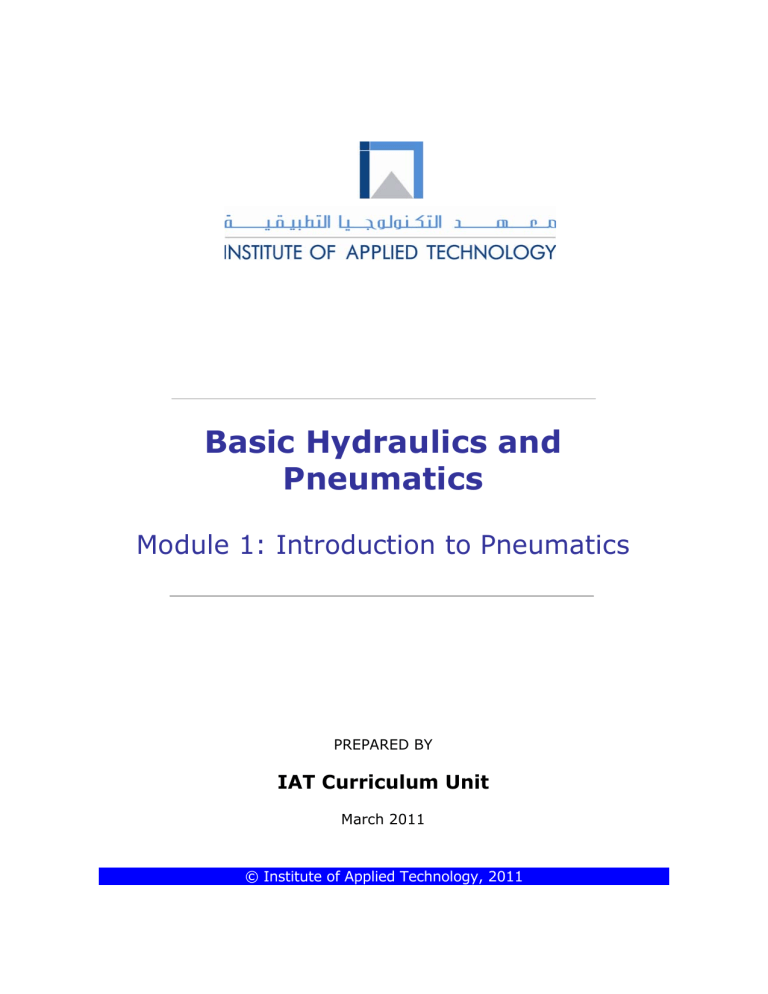
Basic Hydraulics and Pneumatics Module 1: Introduction to Pneumatics PREPARED BY IAT Curriculum Unit March 2011 © Institute of Applied Technology, 2011 ATM 1122 – Basic Hydraulics and Pneumatics Module 1: Introduction to Pneumatics Module Objectives After the completion of this module, the student will be able to: Identify the common uses of pneumatic systems. Identify the main parts of a pneumatic system. Identify the main components of the pneumatic work station TP 101. Understand how to to construct a pneumatic circuit Explain the structure and signal flow of a pneumatic system. List the main parts in the compressed air preparation stage. Identify the symbol of air compressor and its function. Identify the symbol of air tank and its function. Explain the purpose of using the cooling and drying unit Identify the main parts of the air service unit. Identify the symbol of air filter and its function. Identify the symbol of air pressure regulator and its function. Identify the symbol of lubricator and its function. Identify some important pneumatic accessories. ATM 1112 – Basic Hydraulics and Pneumatics Module Contents 1 Introduction….. .............................................................................. 3 1.1 1.2 1.3 2 Applications of pneumatics ……...................................................... 5 2.1 2.2 2.3 3 Advantages................................................................................. 8 Disadvantages............................................................................. 8 Structure and signal flow of pneumatic systems … ........................ 9 4.1 5 industrial applications ……........................................................ 5 Industrial processes … ............................................................ 5 Some of the pneumatic applications in our life … ........................ 6 Advantages and disadvantages of pneumatics … ........................... 8 3.1 3.2 4 What does pneumatic mean…… ................................................ 3 Defentition of pneumatics… ..................................................... 3 What is the fluid power… ......................................................... 3 Primary levels of the pneumatic system … ...................................... 9 Air generation and distribution …................................................. 11 5.1 Preparation the compressed air.. ................................................. 11 5.2 Main parts in the compressed air preparation.. ................................. 12 5.2.1 Air compressor … ................................................................. 12 5.2.2 Air Tank (reservoir)…............................................................ 13 5.2.3 Cooling and drying unit…....................................................... 14 5.2.4 Piping… ............................................................................... 15 5.2.5 Air service unit… .................................................................. 17 6 Pneumatic accessories ................................................................. 20 6.1 6.2 6.3 6.4 Manifold (distributor) …… ...................................................... 20 Shut-off valves … ................................................................. 20 Tubes and fittings … ............................................................. 20 Pressure gauges … ............................................................... 21 References ......................................................................................... 22 2 Module 1: Introduction to pneumatics ATM 1122 – Basic Hydraulics and Pneumatics 1 Introduction 1.1 What Does Pneumatic Mean? Pneumatics comes from the Greek word pneuma, which means 'breath or wind'. It is basically the use of under pressure gas that helps in performing a certain work in science and technology. 1.2 Definition of pneumatics Pneumatics is the transmission and control of forces and movements by means of compressed air. (The use of compressed air as a medium to do work). 1.3 What is the fluid power? Fluid power is the energy transmitted and controlled by means of a pressurized fluid, either liquid or gas. The term fluid power applies to both hydraulics and pneumatics. Hydraulics (oil or water) use liquids under pressure while pneumatics use compressed air or other neutral gases. Pneumatics technology has for some considerable time been used in carrying out the simplest mechanical tasks, but nowadays has played a vital and important role in automation and development of sophisticated technologies. Module 1: Introduction to pneumatics 3 ATM 1112 – Basic Hydraulics and Pneumatics 2 Applications of pneumatics: 2.1 industrial applications Pneumatic systems are used in many industrial applications such as: Material handling Clamping Shifting Positioning Branching of material flow Packaging Filling Transfer of materials Sorting of parts Stamping and embossing of components 2.2 Industrial processes Pneumatic systems are used in carrying out machining and some industrial processes such as: Drilling Turning Milling Sawing Finishing Forming 4 Module 1: Introduction to pneumatics ATM 1122 – Basic Hydraulics and Pneumatics 2.3 Some of the pneumatic applications in our life: A Pneumatic machine is used to dismantle an automobile tire A pneumatic machine is used in an automobile painting A heavy duty pneumatic jackhammer A pneumatic filling machine Module 1: Introduction to pneumatics 5 ATM 1112 – Basic Hydraulics and Pneumatics A dental drill is one of the uses of the pneumatic technology A pneumatic device is used to fill the tire with compressed air to adjust the tire pressure. 6 Module 1: Introduction to pneumatics ATM 1122 – Basic Hydraulics and Pneumatics 3 Advantages and disadvantages of pneumatics: 3.1 Advantages: 1- Availability: Air is available everywhere in unlimited quantities. 2- Transport: Air can be easily transported in pipelines, even over large distances. 3- Storage: Compressed air can be stored in a reservoir/tank and removed as required. 4- Temperature: Compressed air is relatively insensitive to temperature fluctuations. 5- Cleanliness: Unubricated exhaust air is clean. 6- The running cost is relatively inexpensive 7- Speed: Compressed air is a very fast working medium. This enables high working speeds to be attained. 8- Overload safe: Pneumatic tools and operating components can be loaded to the point of stopping and are therefore overload safe. 3.2 Disadvantages: 1- Preparation: Compressed air requires good preparation. Dirt and condensates should be removed. 2- Speed: As air is compressible; it is difficult to achieve uniform and constant piston speed. 3- Force requirement: Compressed air is economical only up to a certain force requirement. Under the normal working pressure of 600 to 700 kPa (6 to 7 bar). 4- Noise level: The exhaust air is loud (noise). This problem has now, however been largely solved due to the development of sound absorption material and silencers. Module 1: Introduction to pneumatics 7 ATM 1112 – Basic Hydraulics and Pneumatics 4 Structure and signal flow of pneumatic systems Pneumatic systems consist of an interconnection of different groups of elements. This group of elements forms a control path for signal flow, starting from the signal section (input) through to the actuating section (output). Control elements control the actuating elements in accordance with the signals received from the processing elements. 4.1 Primary levels of the pneumatic system: Figure 1.1: Pneumatic signal flow and the coreesponding control elements 8 Module 1: Introduction to pneumatics ATM 1122 – Basic Hydraulics and Pneumatics shuttle or double pressure valve 0Z Figure 1.2 : Examples of pneumatic control elements shoen in a practical circuit Module 1: Introduction to pneumatics 9 ATM 1112 – Basic Hydraulics and Pneumatics 5 Air generation and distribution The main function of the air generation and distribution is to provide the system with compressed air which is dry, clean, and at the required pressure The compressed air supply for a pneumatic system should be adequately calculated and made available in the appropriate quality. Air is compressed by the air compressor and delivered to an air distribution system in the factory. To ensure that the quality of the air is acceptable, air service unit is utilized to prepare the air before being supplied to the control system. Malfunctions can be considerably reduced in the system if the compressed air is correctly prepared. A number of aspects must be considered 5.1 Preparation of the compressed air: The following points should be considered in preparing compressed air plants: 1. Quantity of air required to meet the demand of the system 2. Type of compressor to be used to produce the quantity required 3. Pressure requirements 4. Storage requirements 5. Requirements for air cleanliness 6. Acceptable humidity levels to reduce corrosion and sticky operation 7. Lubrication requirements, if necessary 8. Temperature of the air and effects on the system 9. Line sizes and valve sizes to meet demand 10. Material selection to meet environmental and system requirements 11. Drainage points and exhaust outlets in the distribution system 12. Layout of the distribution system to meet demand. 10 Module 1: Introduction to pneumatics ATM 1122 – Basic Hydraulics and Pneumatics 5.2 Main parts in the compressed air preparation 5.2.1 Air compressor: Air compressor is used to produce the compressed air for the system by the required volume and pressure. As a rule, pneumatic components are designed for a maximum operating pressure of 800-1000 kPa (8 - 10 bar) but in practice it is recommended to operate at between 500-600 kPa (5 and 6 bar) for economic and safe use. Due to the pressure losses in the (a) Air compressor distribution system, the compressor should be delivered between 650-700 kPa (6.5 and 7) bar to attain these figures. Figure 1.3.a and figure 1.3.b are examples of air compressors while figure 1.3.c shows the ISO symbol of the air compressor. (b) Air compressor (c) ISO symbol of air compressor Figure 1.3: (a) and (b) are examples of some practical air compressors. (c) ISO symbol of air compressor. Module 1: Introduction to pneumatics 11 ATM 1112 – Basic Hydraulics and Pneumatics 5.2.2 Air Tank (reservoir) An air reservoir should be fitted to: Store and stabilizes the compressed air. Compensate the pressure fluctuation. Cool the air. (a) Air reservoir Figure 1.4 (a) shows a real air tank while the figure 1.4 (b) shows the ISO symbol of an air reservoir. (b) ISO symbol of air reservoir Figure 1.4: (a) air reservoir. (b) ISO symbol of an air reservoir. 12 Module 1: Introduction to pneumatics ATM 1122 – Basic Hydraulics and Pneumatics 5.2.3 Cooling and drying unit As the air comes out from the compressor very hot and humid; The cooling and drying unit is used to: Condensate the water vapor (humidity) from the compressed air. Reduce the compressed air temperature. The accumulation of condensate (a) depends largely on the relative air humidity. The relative air humidity is dependent temperature and on the the air weather situation. To remove the humidity, we use many types of air dryers, the very common and practical one is by using a cooling unit which cool the air and at the same time remove the water vapor. Figure 1.5 (a) and (b) show some examples of (b) real air dryers, while figure 1.5.c represents an ISO symbol of air dryer. (c) Figure 1.5: (a): and (b) are some examples of real air dryers. (c) ISO symbol of air dryer. Module 1: Introduction to pneumatics 13 ATM 1112 – Basic Hydraulics and Pneumatics 5.2.4 Piping The pipe diameter of the air distribution system should be selected in such a way that the pressure loss from the pressurized reservoir to the consuming device ideally does not exceed approx. 10 kPa (0.1 bar). 5.2.4.1 Selection of the pipe diameter: 1. Flow rate 2. Line length 3. Permissible pressure loss 4. Operating pressure 5. Number of flow control points in the line 5.2.4.2 Piping layout Ring circuits (figure 1.6.a) are most frequently used as main lines. This method of installing pressure lines also achieves a constant supply in the case of high air consumption. In pipe-run layout, the pipe lines must be installed in the direction of flow with a gradient of 1 to 2% as shown in figure 1.6 b. This is particularly important in the case of branch lines. Condensate can be removed from the lines at the lowest point. Any branching of air consumption points where lines run horizontally should always be installed on the upper side of the main line. Branching for condensate removal is installed on the underside of the main line. Shut-off valves can be used to block sections of compressed air lines if these are not required or need to be closed down for repair or maintenance purposes. 14 Module 1: Introduction to pneumatics ATM 1122 – Basic Hydraulics and Pneumatics (a) Ring (loop) pneumatic distribution system (b) pipe-run pneumatic distribution system Figure 1.6 : (a) shows the ring or loop distribution system. (b) shows the piperun distribution system Module 1: Introduction to pneumatics 15 ATM 1112 – Basic Hydraulics and Pneumatics .5.2.5 Air service unit The air service unit shown in figure 1.7.a is a combination of the following: 1. Compressed air filter (with water separator) 2. Compressed air regulator 3. Compressed air lubricator The main function of the service unit (a) picture of an air service unit is provide the pneumatic system with a well cleaned, lubricated and regulated compressed air. (Condition the compressed air). Removal of most contaminants (water, compressor oil, dirt, rust, pipe (b) Detailed ISO symbol of the service unit scale and other foreign materials). Obviously, an inefficient system results in higher costs per unit of compressed air, improper or erratic (c) Simplified ISO symbol of the tool operation, shortened component service unit life, reduced capacity and the formation of rust and sludge in the Figure 1.7: (a) Shows a real service main and branch lines. unit. (b) ISO symbol of the service unit. (c) Simplified ISO symbol of the service unit. 16 Module 1: Introduction to pneumatics ATM 1122 – Basic Hydraulics and Pneumatics 5.2.5 .1 Air filter Compressed air filter (Figure 1.8a) has the job of removing all contaminants from the compressed air flowing through it as well as water which has already condensed. The compressed air enters the filter bowl through guide slots. Liquid particles and larger particles of dirt are separated centrifugally collecting in (a)a picture of a real air filter the lower part of the filter bowl. The collected condensate must be drained before the level exceeds the maximum condensate mark, as it will otherwise be re-entrained in the air (b) ISO symbol of the air filter stream. Figure 1.8: (a) air filter.(b) The ISO symbol of an air filter Module 1: Introduction to pneumatics 17 ATM 1112 – Basic Hydraulics and Pneumatics 5.2.5 .2 Pressure regulator (Reduce/regulate the pressure). The purpose of the regulator (figure 1.9.a) is to keep the operating pressure of the system (secondary pressure) virtually constant regardless (a) real pressure regulator of fluctuations in the line pressure (primary pressure) and the air consumption. Figure 1.9.b represents the ISO symbol of the air regulator. 5.2.5 .3 (b) ISO symbol of the pressure Air lubricator regulator. (Lubricate the moving parts) Most moving parts require some type of lubrication. The efficiency of cylinders, valves and air motors can be greatly improved if they are supplied with adequate lubrication. Pneumatic lubricated components by using an can be air line lubricator (figure 1.9.c), a device for adding lubricating oil in aerosol form (c) air lubricator into a compressed air line. The air passing through the lubricator transports the lubricant to air tools, cylinders or other air operated (d) ISO symbol of the air lubricator. equipment. Figure 1.9.d represents an Figure 1.9: (a) pressure regulator.(b) ISO symbol of the pressure regulator. ISO symbol of the air lubricator (c) Air lubricator. (d)ISO symbol of the air lubricator. 18 Module 1: Introduction to pneumatics ATM 1122 – Basic Hydraulics and Pneumatics 6 pneumatic accessories Other important components that are used in the pneumatic lab 6.1 Manifold (distributor): it is used to pressure shows provide outlets. a multi equal Figure 1.10.a pneumatic manifold Figure 1.10.b (distributor). represents the ISO symbol of the pneumatic manifold. (a) pneumatic manifold (distributor) Each output port has check valve (Non return valve). (b) ISO symbol of the pneumatic manifold 6.2 Shut off valves It is used to open and close the compressed manually.Figure air 1.8.c supply shows a sample of shut-off valve. Figure 1.10d represents the ISO symbol of the shut-off valve (c) Sample of a shut-off valve 6.3 (d) ISO symbol of the shut-off valve Tubes and fittings Figure 1.10e shows some types of tubes that are used in connecting pneumatic circuits. Figure 1.10f shows some important fittings such as T connections and cross connections. (e) some types of tubes Module 1: Introduction to pneumatics 19 ATM 1112 – Basic Hydraulics and Pneumatics 6.4 It Pressure gauge used to display the actual amount of the pressure in two main units Pascal and bar 1 bar= 14.5 p.s.i Figure 1.10g pressure shows gauge. Figure a real (f) different fittings 1.10h represents the ISO symbol of the pressure gauge. (g) pneumatic pressure gauge (h) ISO symbol of a pressure gauge Figure 1.10 Activity: Compare between hydraulics and pneumatics. 20 Module 1: Introduction to pneumatics ATM 1122 – Basic Hydraulics and Pneumatics References 1. Festo Didactic pneumatic basic level textbook TP 101. 2. Introduction to fluid power by James L. Johnson 3. http://www.omega.com/auto/pdf/CompressedAirTips.pdf Module 1: Introduction to pneumatics 21 ATM 1112 – Basic Hydraulics and Pneumatics Student notes …………………………………………………………………………………………………………………………….......................... …………………………………………………………………………………………………………………………….......................... …………………………………………………………………………………………………………………………….......................... …………………………………………………………………………………………………………………………….......................... …………………………………………………………………………………………………………………………….......................... …………………………………………………………………………………………………………………………….......................... …………………………………………………………………………………………………………………………….......................... …………………………………………………………………………………………………………………………….......................... …………………………………………………………………………………………………………………………….......................... …………………………………………………………………………………………………………………………….......................... …………………………………………………………………………………………………………………………….......................... …………………………………………………………………………………………………………………………….......................... …………………………………………………………………………………………………………………………….......................... …………………………………………………………………………………………………………………………….......................... …………………………………………………………………………………………………………………………….......................... …………………………………………………………………………………………………………………………….......................... …………………………………………………………………………………………………………………………….......................... …………………………………………………………………………………………………………………………….......................... …………………………………………………………………………………………………………………………….......................... …………………………………………………………………………………………………………………………….......................... …………………………………………………………………………………………………………………………….......................... …………………………………………………………………………………………………………………………….......................... …………………………………………………………………………………………………………………………….......................... …………………………………………………………………………………………………………………………….......................... …………………………………………………………………………………………………………………………….......................... …………………………………………………………………………………………………………………………….......................... …………………………………………………………………………………………………………………………….......................... 22 Module 1: Introduction to pneumatics
